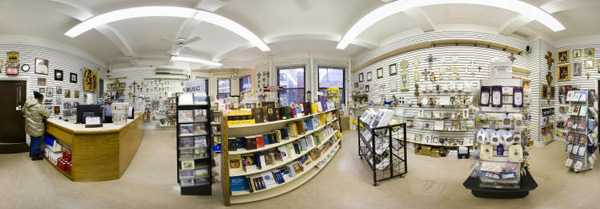
Christ the Consolator by Bloch
In Paris on March 24 and 25, a remarkable new Church initiative began. Born from the pastoral zeal, Biblical expertise and the university experience of Pope Benedict XVI, it is an attempt to establish a dialogue with non-believers modeled on the ancient Temple of Jerusalem’s courtyard of the gentiles, where non-Jews would come to query the scribes about the Jewish faith, debate the meaning of existence and, if they so desired, pray, either to a God who remained mysterious to them or to the One whom they believed had revealed Himself to the Jews. Since the Second Vatican Council, the Church has worked very hard to establish an ecumenical dialogue with other Christian Churches and ecclesial communities as well as an interreligious dialogue with other major religions. Curiously absent from a structure conversation and joint search for truth, however, has been a forum for discussion with non-believers. The Courtyard of the Gentiles is an attempt to remedy that lacuna.
The idea for a Court of the Gentiles was first mentioned by Pope Benedict in his pre-Christmas address to the Roman Curia in 2009. Reflecting on his pilgrimage to the Czech Republic, a country with many “seekers” — agnostics searching for the answers to the deepest human questions — Pope Benedict reflected on the words Jesus quoted from Isaiah, that the Temple “must be a house of prayer for all the nations” (Is 56:7; Mk 11:17). “Jesus,” the Pope said, “was thinking of the so-called ‘Courtyard of the Gentiles’ which he cleared of extraneous affairs so that it could be a free space for the Gentiles who wished to pray there to the one God, even if they could not take part in the mystery for whose service the inner part of the Temple was reserved.” Benedict said that there are many who “know God, so to speak, only from afar; who are dissatisfied with their own gods, rites and myths; who desire the Pure and the Great, even if God remains for them the ‘unknown God’” referred to by St. Paul in his speech at the Athenian Areopagus. “I think that today too the Church should open a sort of ‘Courtyard of the Gentiles,’ in which people might in some way latch on to God, without knowing him and before gaining access to his mystery … who nevertheless do not want to be left merely Godless, but rather to draw near to him, albeit as the Unknown.”
That desire was soon put into motion by Cardinal Giovanni Ravasi, the affable, engaging and learned President of the Pontifical Academy for Culture, who decided to launch the idea in Paris, the symbolic birthplace and home of the enlightenment. At three institutions with unimpeachable secular credentials — UNESCO, the Sorbonne and the L’Institut de France — there were discussions and presentations by believers and non-believers; the whole event culminated in the square or “courtyard” of Notre Dame Cathedral, where Pope Benedict gave a live televised address.
The next Courtyard, a dialogue on technology and science, will be held in Chicago. Others are being planned for Albania, Sweden, Quebec, and Asia.
In his address to those assembled in the Notre Dame plaza, Pope Benedict expressed his joy that the Pontifical Council for Culture had taken up his desire that a dialogue with non-believers be established and that so many believers and non-believers had responded. “At the heart of the ‘City of Light,’ in front of the magnificent masterwork of French religious culture which is Notre Dame, a great court has been created in order to give fresh impetus to respectful and friendly encounter between people of differing convictions,” Pope Benedict said. “Believers and nonbelievers alike have chosen to come together, as you do in your daily lives, in order to meet one another and to discuss the great questions of human existence.” Speaking about God together, he implied, should be as natural for believers and non-believers as going to school, to the grocer, or to work together.
He began the heart of his address by turning to non-believers, praising their deepest desires and validating some of their just criticisms of believers and religious institutions. “Nowadays,” he said, “many people acknowledge that they are not part of any religion, yet they long for a new world, a world that is freer, more just and united, more peaceful and happy. … Those of you who are nonbelievers challenge believers in a particular way to live in a way consistent with the faith they profess and by your rejection of any distortion of religion that would make it unworthy of man.” In saying this, Benedict was echoing one of the great, but hidden, insights of the Second Vatican Council, which noted that one of the principle causes for non-belief in the world is precisely the lack of integrity found in the lives of Christians. “Believers can have more than a little to do with the birth of atheism. To the extent that they neglect their own training in the faith, or teach erroneous doctrine, or are deficient in their religious, moral or social life, believers must be said to conceal rather than reveal the authentic face of God and religion” (Gaudium et Spes, 19). Pope Benedict wanted to acknowledge that reality head on, especially after the sexual abuse scandals involving Catholic clergy concealed God’s and the Church’s true face to non-believers even further.
Pope Benedict, however, also wanted to tackle directly another disfigurement. He said that in a highly secularized society that often is prejudiced and intolerant to religious belief, believers have a deep desire to tell others that faith is a “treasure” rather than a poison. Questions about God, he stressed, ennoble rather than harm man. “The question of God is not a menace to society,” Benedict exclaimed. “It does not threaten a truly human life! The question of God must not be absent from the other great questions of our time.”
The path of dialogue, he indicated, is not just a path of mutual tolerance but rather of mutual cooperation and search for the truth. He called the participants to “build bridges between one another,” and “work to break down the barriers of fear of others … born of mutual ignorance, skepticism or indifference.” He asked them to make “a courageous decision to seek the truth,” and to help their fellow believers and nonbelievers to “rediscover the path of dialogue.” Just as non-believers have nothing to fear from God, so “religions have nothing to fear from a just secularity, one that is open and allows individuals to live in accordance with what they believe in their own consciences.” Taking up and applying the motto of the French revolutionaries, he said, “If we are to build a world of liberty, equality and fraternity, then believers and nonbelievers must feel free to be just that, equal in their right to live as individuals and in community in accord with their convictions; and fraternal in their relations with one another.” He declared that one of the reasons for the Courtyard of the Gentiles is “to encourage such feelings of fraternity, over and above our individual convictions yet not denying our differences.” He also suggested — in a point that ought to be pondered — that the bridges believers and nonbelievers build between each other might likewise prove to be bridges between both groups and God, since each person, as a creature of God, is “in some way the road that leads to God.”
After the successful inauguration of the Courtyard of the Gentiles, Cardinal Ravasi noted in an interview that the Church’s hope is not for the Courtyard to remain a series of itinerant events sponsored by a Vatican Pontifical Council but rather a “fixture of the pastoral activity of every diocese.” As the numbers of non-believers in the state of Massachusetts and elsewhere continues to grow, as we seek to give witness to the faith in the midst of the modern areopagus of so many colleges and universities, and as the number of misconceptions about the Church has multiplied due to the scandals as well as to the way the truth about the Church has been only partially portrayed in some secular news outlets, the time is doubtless at hand for us to respond to the Holy Father’s initiative and open up a courtyard — or several courtyards — here.
Please help us in our mission to assist readers to integrate their Catholic faith, family and work. Share this article with your family and friends via email and social media. We value your comments and encourage you to leave your thoughts below. Thank you! – The Editors












